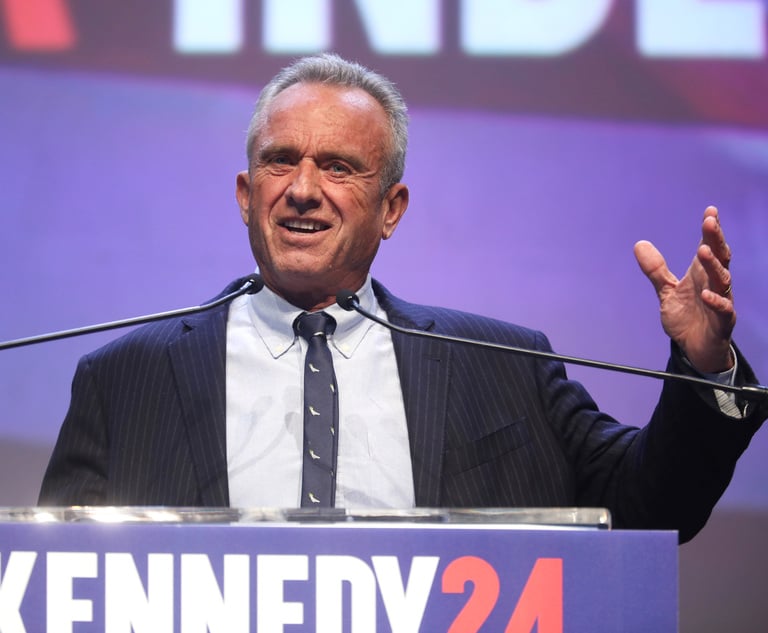 Jerome Powell, chair of the U.S. Federal Reserve. Photo: Graeme Jennings/Washington Examiner/Bloomberg
Jerome Powell, chair of the U.S. Federal Reserve. Photo: Graeme Jennings/Washington Examiner/Bloomberg Traders Brace for Possibility of 5 Fed Rate Hikes This Year
Investors are speculating whether Federal Reserve Chair Jerome Powell will front-load hikes by potentially making a rare 50-basis-point move in March.
January 27, 2022 at 01:55 PM
4 minute read
Traders are boosting bets for higher borrowing costs, with money markets now expecting almost five interest-rate increases from the Federal Reserve this year and another four from the Bank of England.
Investors are also speculating whether Fed Chair Jerome Powell will front-load hikes by potentially making a rare 50-basis-point move in March, after he struck a hawkish tone at this week's meeting. The wagers rippled through markets, with short-dated bonds slumping and the dollar rallying. CME open interest data following Wednesday's selloff showed a build-up of new short positions across the Treasuries curve as yields surged higher.
The pace of rate hikes being indicated by front-end markets, which at one point Thursday showed five quarter-point increases for 2022 fully priced in, eased back slightly in early New York trading, although traders aren't far from that level. They are also pricing around 30 basis points into the March meeting, suggesting some bets on a super-sized half-point hike then.
U.S. gross domestic product growth figures for the last quarter of 2021 came in stronger than expected, at an annualized pace of 6.9%, although there was little reaction in rates pricing given the market has already taken on a hawkish tilt in the wake of the Fed meeting.
Shortly after Wednesday's Fed policy announcement, Nomura Holdings Inc. changed its forecast for Federal Reserve interest-rate hikes, with the bank now expecting a 50 basis-point increase in March. Money markets are currently pricing a half point of tightening by the May policy meeting. On Thursday, the three-month dollar Libor rate fixed over 2 basis points higher, largest rise since November 2020.
"People are getting serious about a 50-basis-point hike," said Rishi Mishra, an analyst at Futures First.
The tone of Powell's press conference leaves no doubt that price stability takes precedence over other policy goals, meaning there's even an upside risk of six hikes, Bloomberg Intelligence's Anna Wong wrote in a note.
"My biggest disagreement with market pricing though is in the context of a terminal rate in the cycle, where the market discounts rates topping at 2%," said Mark Dowding, CIO of BlueBay Asset Management. "I think this is 100 basis points too low and see rates getting to 3% in 2024."
The on-off bets on faster policy tightening in recent months have spurred greater volatility across markets. U.K. bonds took the biggest hit Thursday, with two-year yields climbing to the highest since 2011. The Treasury curve flattened as two-year yields rose three basis points while their 10-year peers fell by just as much.
The rate-hike fever spread in Europe, with traders betting on a 25-basis-point move by the Bank of England next week to 0.5%. Money markets see the bank rate at 1% by June and then climbing to almost 1.5% by December. That wasn't enough to prop up the pound against a resurgent dollar.
The European Central Bank, which has consistently sounded more dovish than its major peers, is now expected to hike its deposit rate by 10 basis points to minus 0.4% by September, from October previously. Policymakers led by Christine Lagarde next meet on Feb. 3.
"It will be really interesting to see if Lagarde will push back on 2022 pricing — the question is if she can convince markets," said Piet Christiansen, chief strategist at Danske Bank A/S. "I think she will still say that uncertainty is high and it is highly unlikely to raise rates this year. In this market, it's not time for high conviction calls on central bank pricing."
James Hirai and Greg Ritchie report for Bloomberg News.
NOT FOR REPRINT
© 2025 ALM Global, LLC, All Rights Reserved. Request academic re-use from www.copyright.com. All other uses, submit a request to [email protected]. For more information visit Asset & Logo Licensing.
You Might Like
View All

Lawyers' Phones Are Ringing: What Should Employers Do If ICE Raids Their Business?
6 minute read

RFK Jr. Will Keep Affiliations With Morgan & Morgan, Other Law Firms If Confirmed to DHHS
3 minute readTrending Stories
- 1Uber Files RICO Suit Against Plaintiff-Side Firms Alleging Fraudulent Injury Claims
- 2The Law Firm Disrupted: Scrutinizing the Elephant More Than the Mouse
- 3Inherent Diminished Value Damages Unavailable to 3rd-Party Claimants, Court Says
- 4Pa. Defense Firm Sued by Client Over Ex-Eagles Player's $43.5M Med Mal Win
- 5Losses Mount at Morris Manning, but Departing Ex-Chair Stays Bullish About His Old Firm's Future
Who Got The Work
J. Brugh Lower of Gibbons has entered an appearance for industrial equipment supplier Devco Corporation in a pending trademark infringement lawsuit. The suit, accusing the defendant of selling knock-off Graco products, was filed Dec. 18 in New Jersey District Court by Rivkin Radler on behalf of Graco Inc. and Graco Minnesota. The case, assigned to U.S. District Judge Zahid N. Quraishi, is 3:24-cv-11294, Graco Inc. et al v. Devco Corporation.
Who Got The Work
Rebecca Maller-Stein and Kent A. Yalowitz of Arnold & Porter Kaye Scholer have entered their appearances for Hanaco Venture Capital and its executives, Lior Prosor and David Frankel, in a pending securities lawsuit. The action, filed on Dec. 24 in New York Southern District Court by Zell, Aron & Co. on behalf of Goldeneye Advisors, accuses the defendants of negligently and fraudulently managing the plaintiff's $1 million investment. The case, assigned to U.S. District Judge Vernon S. Broderick, is 1:24-cv-09918, Goldeneye Advisors, LLC v. Hanaco Venture Capital, Ltd. et al.
Who Got The Work
Attorneys from A&O Shearman has stepped in as defense counsel for Toronto-Dominion Bank and other defendants in a pending securities class action. The suit, filed Dec. 11 in New York Southern District Court by Bleichmar Fonti & Auld, accuses the defendants of concealing the bank's 'pervasive' deficiencies in regards to its compliance with the Bank Secrecy Act and the quality of its anti-money laundering controls. The case, assigned to U.S. District Judge Arun Subramanian, is 1:24-cv-09445, Gonzalez v. The Toronto-Dominion Bank et al.
Who Got The Work
Crown Castle International, a Pennsylvania company providing shared communications infrastructure, has turned to Luke D. Wolf of Gordon Rees Scully Mansukhani to fend off a pending breach-of-contract lawsuit. The court action, filed Nov. 25 in Michigan Eastern District Court by Hooper Hathaway PC on behalf of The Town Residences LLC, accuses Crown Castle of failing to transfer approximately $30,000 in utility payments from T-Mobile in breach of a roof-top lease and assignment agreement. The case, assigned to U.S. District Judge Susan K. Declercq, is 2:24-cv-13131, The Town Residences LLC v. T-Mobile US, Inc. et al.
Who Got The Work
Wilfred P. Coronato and Daniel M. Schwartz of McCarter & English have stepped in as defense counsel to Electrolux Home Products Inc. in a pending product liability lawsuit. The court action, filed Nov. 26 in New York Eastern District Court by Poulos Lopiccolo PC and Nagel Rice LLP on behalf of David Stern, alleges that the defendant's refrigerators’ drawers and shelving repeatedly break and fall apart within months after purchase. The case, assigned to U.S. District Judge Joan M. Azrack, is 2:24-cv-08204, Stern v. Electrolux Home Products, Inc.
Featured Firms
Law Offices of Gary Martin Hays & Associates, P.C.
(470) 294-1674
Law Offices of Mark E. Salomone
(857) 444-6468
Smith & Hassler
(713) 739-1250






